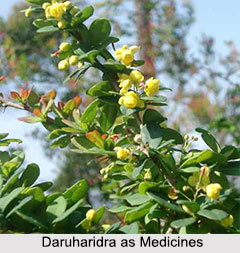 Daruharidra, scientifically named as "Berberis Aristata" is used in Ayurveda to treat eye disorders, skin disorders with itching, diabetes, urinary tract diseases, etc. This is found in Himalaya and Nepal region.
Daruharidra, scientifically named as "Berberis Aristata" is used in Ayurveda to treat eye disorders, skin disorders with itching, diabetes, urinary tract diseases, etc. This is found in Himalaya and Nepal region.
Health Benefits of Daruharidra
Charaka has mentioned this as one of the herbs used in powder massage, useful in pruritis, acne and urticaria. The wood, root-bark and extract of Indian Barberry have been used in Hindu Medicine from a very remote period. Its properties are said to be analogous to those of turmeric. Indian barberry and its extract are regarded as alterative and deobstruent, and are used in skin diseases, menorrhagia, diarrhoea, jaundice and above all, in affections of the eyes.
Extract of Daruharidra
The extract, called "Rasanjana" in Sanskrit and "Rasot" in the vernacular. It is directed to be prepared by boiling together equal parts of a decoction of Indian barberry and milk, till reduced to the consistence of an extract. The extract thus prepared, is said to be particularly useful in affections of the eyes.
In the Intertrigo of infants, rasot is recommended to be applied externally and administered internally. Rasot mixed with honey, is said to be a useful application to aphthous sores. The principal use of rasot however is in eye-diseases, in which it is employed in a great variety of forms. The following are a few illustrations.
•Take rasot, chebulic myrobalan, rock salt and red ochre, equal parts, rub them together into paste with water and apply round the orbit in inflammatory affections of the eyes.
•Rasot mixed with honey may also be used in the same way.
•An emulsion of rasot made with milk is recommended to be poured into the eyes, or used as a collyrium for relieving pain, burning and lachrymation.
Compound Powder of Daruharidra
Rasanjanadi Churna is the compound powder of rasot. To prepare the powder; take rasot, atis, the bark and seeds of Holarrhena antidysenterica, flowers of Woodfordia floribunda (dhataki) and ginger in equal parts, powder it and mix. Dose should be about a drachm with rice water (tandulambu) and honey. This powder is said to be useful in bilious diarrhoea.
Compound Decoction of Daruharidra
Sarangadhara recommends a simple decoction of Indian barberry to be given with the addition of honey in jaundice. In painful micturition from bilious or acrid urine, a decoction of Indian barberry and emblic myrobalan is given with honey. A decoction of the root bark is used as a wash for unhealthy ulcers, and is said to improve their appearance and promote cicatrization.
Darvyadi Kvatha is the compound decoction of Indian barberry. To prepare the decoction; take the root bark of Indian barberry, rasot, chiretta, Adhatoda Vasica (Vasaka), Cyperus rotundus (mustaka), bela fruit and marking nuts in equal parts and prepare a decoction in the usual way. This is administered with honey in menorrhagia and copious discharges from the womb. Another combination said to be very useful in menorrhagia is as follows; take rasot and the root of Amaranthus spinosus (tanduliya) in equal parts, beat into a paste with water and administer with honey and water in which rice has been steeped.
Related Articles
Origin of Ayurveda
Ayurveda Medication
Elements of Ayurveda
Concepts of Ayurveda
Ancient Literature of Ayurveda
Use of Vegetables or Plants as Medicines





